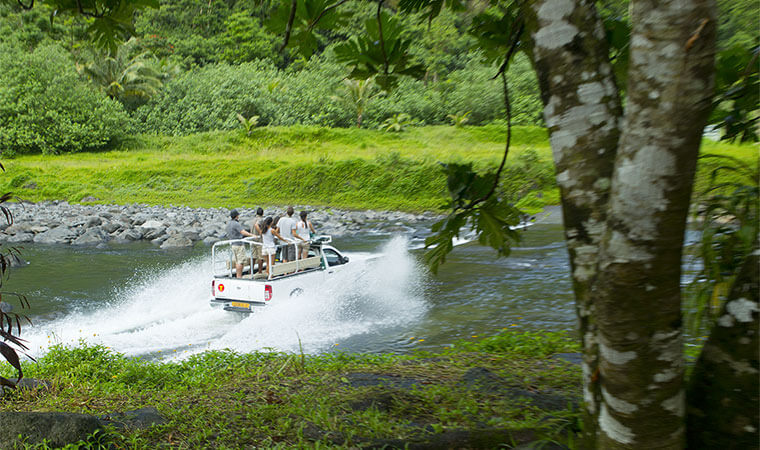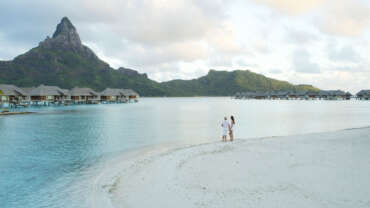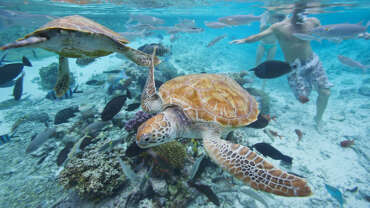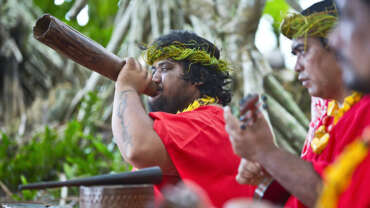Outdoor Adventure in Tahiti
There are so many ways to discover the outdoors in The Islands of Tahiti, and so many opportunities for hikes and excursions in island valleys or over hilltops where the breathtaking views encompass a full 360-degree panorama of mountains, bays, lagoons and on the horizon, the immense Pacific.
From canoeing to paddle boarding to soaring over the sea on a paraglider, you’ll never find a shortage of things to do in the great outdoors in The Islands of Tahiti. Explore your options here.
How Can I explore The Islands of Tahiti?
Activities On Land
On Foot
In the high islands, you’ll discover many walking tracks that lead to amazing lookout points, winding through wild valleys and undergrowth, in the shade of mape trees (Tahitian chestnut trees) as you search for the mysterious marae or religious places. Guides are qualified, offer high quality services and will keep you safe.
On Horseback
Across spectacular landscapes with the valleys and the plateaux of the Marquesas islands, rich in archaeological remains, or along the white sand beaches (Tahiti, Huahine, Moorea and more), with the sun setting as a backdrop, or even going upstream from the rivers, crossing dense vegetation (Raiatea, Tahaa and more).
By Bike
While a normal bike is ideal for the flat ring road, you’ll want a mountain bike for making your way into the interior of the islands. Many hotels offer them for hire.
By 4×4 / Quad Bikes
Excursions in off-road vehicles make it easy to effortlessly explore the mountainous, inner isles. Cars, scooters, “fun cars” and quad bikes are also available for hire in certain islands.
Ziplining
It is a playground in the trees! Self-guided aerial adventure park that provides hours of thrills and challenges for all ages and abilities. Options range from a kids’ course, through mid-level trails, all the way to expert level. Tackle as many obstacles as you want! The adventure parks offer a series of platforms in the trees connected by ladders, bridges, ropes, ziplines and obstacles of every kind, all situated in lush mountainous terrain.
Adventures In The Air
Skydiving
Free-fall for an unforgettable experience as you enjoy the view above the lagoons of Moorea, Bora Bora or Tahiti. Skydiving jumps take place in tandem with a professional skydiving instructor. You can find skydiving tour operators on Moorea, Bora Bora and Tahiti (at sunset).
Parasailing
Find yourself amazed by the turquoise waters. This is a novel way to enjoy the view from the sky, solo or in tandem, towed by a cable up to 900 feet long. Flying 600 feet above an improbable palette of turquoise is an experience you’ll remember forever. This activity is offered by Mahana Parasail in Bora-Bora and Moorea.
Aerobatics and Flying Lessons
If you’re a thrill-seeker, then aerobatics are for you. After taking off from Tahiti-Faa’a airport with a pilot-instructor, you’ll have the opportunity to improve your flying skills high above the lagoon. Lessons are offered at every level, from beginner to pilot’s license. Just want to kick back and enjoy the view? Discovery flights around Tahiti are also available on request.
Paragliding
A completely safe tandem overflight of Tahiti, its steep-sided valleys, its plateaus and its lagoon. Paragliding is an affordable sport that is available to all ages with no particular physical fitness requirement.
Tourist flights
Flights which will allow you to discover an incredible experience over some of the most beautiful lagoons in the world. Whatever circuit you choose, you will enjoy a panoramic view, and you will be amazed by the shades of blue that will dazzle your eyes. These flights are opportunities to take exceptional photos or videos for unique and unforgettable memories. You will fly comfortably and safely aboard an aircraft captained by an experienced pilot who knows the area perfectly.
Water Activities
Surfing, Stand-up Paddle Boarding and Bodyboarding
Whether it’s surfing, stand up paddle or bodyboarding – Polynesia is a paradise for surfers of all levels, both beginners and professionals. It provides a multitude of locations, ranging from the waves on the beach to the most dangerous waves over coral reefs and passes. The island of Tahiti alone has more than thirty surfing spots, of which three are world famous: Teahupo’o, Taapuna and Maraa. In the southern winter (May to November), the best waves unfurl over the north coast while the south coast takes the waves for the rest of the year. Moorea, with the Tema’e site on its east coast, is also excellent. Finally, there are still secret spots in the islands frequented by pros and locals, mostly in the Tuamotu and Marquesas Islands.
Kitesurfing, Funboarding and Wind Surfing
Whether it’s kitesurfing, funboarding or wind surfing – in Tahiti and in the islands, even the smallest breath of wind and a hint of sun are enough to bring out the kiteboards and windsurfers. These sports are very popular and it’s easy to see why. They are 100 percent ecological and they open up new horizons for lovers of nautical adventures. The Islands of Tahiti combine all the ingredients that let you fully appreciate these disciplines, whatever your level. Go water sporting on calm, safe waters – learn on the lagoons to start with, then increase speed and cover distance; and then on waves for surfing and jumping. And all this, together with a tropical climate, warm, crystal-clear water and breath-taking landscapes.
Outrigger Canoeing and Sailing
Whether it’s outrigger canoeing or sailing – the lagoons with their calm waters offer tons of opportunities for sailing and anchoring. So, everything from the traditional outrigger canoe to the racing course pirogue, from the great sailing ship to the simple kayak navigates over this marine paradise. These boats can be hired in most of the islands, including Taha’a and Raiatea.
Hiking in Tahiti
The Islands of Tahiti are famed for their crystal-clear turquoise lagoons and picturesque overwater bungalows. Yet, to experience The Islands of Tahiti in all their majesty, it is important to consider the adventures that lie inland; home to spectacular waterfalls, striking mountain peaks, lush valleys, and ancient ruins, there is much to be explored and appreciated.
Whether you are a beginner or more advanced, there are plenty of opportunities for hiking in Tahiti; you are sure to have an unforgettable experience in one of the most exquisite places on Earth. A local guide is recommended, as access to many of the trailheads can be tricky; certain areas require hikers to obtain permits beforehand, and others can only be accessed by 4×4. Here are some of the best places to go hiking in Tahiti, Moorea, and Bora Bora.
Hiking in French Polynesia
Tahiti is the most developed and populous island in French Polynesia, also known as The Islands of Tahiti. Beyond the hustle and bustle of Papeete, its capital city, lies a remarkable landscape rich in hiking opportunities.
Easy Hiking Trails In Tahiti
Papenoo Valley
Great for families, the Papenoo Valley is home to some of the most popular hiking trails in Tahiti. The Papenoo Valley offers a well-rounded glimpse of Tahiti’s landscape: magnificent waterfalls, ancient archaeological sites, lush, tropical vegetation, and picturesque canyons. Here you can find the only hike in Tahiti that allows access to the Mt. Orohena volcanic crater.
Te Pari
Located in the southernmost part of Tahiti Iti, the Te Pari trail is accessible only by boat and offers an expedition into the uninhabited natural area of Tahiti. This scenic coastal hike ventures between the ocean and the Te Pari Cliffs with many points of interest along the way, including white sandy beaches, coral flats, the famous Vaipoiri Cave, lava tubes, the Queen’s Bathing Pool, and much more.
Faraura Valley
For those interested in seeing waterfalls while hiking in Tahiti, a visit to the Faraura Valley is a must. Explore four spectacular waterfalls and their glistening basins, the Mahateaho River, and lush Tahitian flora while immersing yourself in the legends associated with the valley’s landmarks.
Fautaua Valley
Located near Papeete, the Fautaua Valley trail offers a relatively easy hike through a forest of lush, tropical vegetation. There are several points of interest along this trail, including the Fachoda Bridge and Fachoda Fort, the Fautaua Waterfall, the Governor’s Gardens, Teovere Pass, and stunning views of the Diadem Mountain. You must obtain an access permit from Papeete Town Hall before accessing this hiking trail in Tahiti.
Moderate Hiking Trails In Tahiti
Hitiaa Lava Tubes
The Hitiaa lava tubes near Taravao are some of the most unique and magnificent hiking trails in Tahiti. Formed hundreds of thousands of years ago when hot lava cooled and rapidly hardened, these lava tubes provide an extraordinary spelunking experience; visitors will have to hike in the darkness and swim during this adventure through the cave system. The lava tubes, hidden pools, and waterfalls are well worth the effort.
Faananu Valley
Located east of Papeete, the Faananu Valley is renowned for its rich and diverse endemic vegetation. Great for canyon enthusiasts, this lush hiking trail in Tahiti features striking landscapes, waterfalls, and native flora.
Difficult Hiking Trails In Tahiti
Mt. Aorai
Mt. Aorai is the third-highest peak in Tahiti, rising 2,066 meters. The trail is well-marked and maintained, so although a guide isn’t necessary, one is recommended for safety purposes as the path winds along a narrow ridge. The scenic trail is lush and features fascinating local flora. Some say that the panoramic views from the summit are some of the best in the world.
Hiking in Moorea
Moorea is a quick ferry ride away from Tahiti. A peaceful and slow-paced island, Moorea is a hidden gem with stunning natural wonders. Beyond the turquoise lagoon and glistening bays lie emerald peaks, fragrant pineapple fields, and lush valleys just waiting to be explored.
Easy Hiking Trails In Moorea
Three Coconuts Pass (Col des Trois Cocotiers)
The most popular hiking trail in Moorea, Three Coconuts Pass is well-maintained and easy to follow. The trail begins at the Belvedere parking lot and offers impressive views of Mount Tohivea, the Opunohu Valley, Opunohu Bay, Cook’s Bay, and more.
Three Pines Pass (Col des Trois Pinus)
Named for the three distinct pine trees found along the trail, Three Pines Pass offers impressive views of Mount Rotui, Opunohu Bay, and Cook’s Bay, as well as the famous pineapple fields of Moorea.
Moderate Hiking Trails In Moorea
Afareaitu Waterfall
Located in the Afareaitu Valley, the trail to the Afareaitu Waterfall is relatively short and has many points of interest along the way. Rich, colorful vegetation abounds, and visitors can delight in taking a refreshing dip in the glistening pools beneath the picturesque falls.
Explore guided hiking in Moorea here.
Hiking in Bora Bora
Bora Bora is world-renowned for its pristine white-sand beaches, crystal-clear turquoise waters, and luxurious overwater bungalows, which is why it may come as a surprise that there are some excellent opportunities for hiking in Bora Bora. Bora Bora’s iconic peaks are steeped in history and legend, providing a transformative experience to those fortunate enough to traverse them.
Easy Hiking Trails In Bora Bora
Ancestors’ Path – Valley of the Kings
Winding through the Valley of the Kings, the Ancestors’ Path in Bora Bora is famous for the giant banyan tree that sits atop the valley (fun fact: this very tree was the inspiration behind the Tree of Souls in the Avatar film!). The banyan tree has great cultural significance, as it served as the final resting place for the kings of Bora Bora. This trail features ancient temples and colorful native flora, culminating at an exquisite outlook with panoramic views of the famous Bora Bora lagoon and neighboring islands.
Moderate Hiking Trails In Bora Bora
Mount Otemanu
Mount Otemanu is the most iconic peak in The Islands of Tahiti. While it is not possible to reach the summit by foot due to safety reasons, visitors can still explore its various hiking trails, including the path to the Cave of Mount Otemanu on the northeastern side of the mountain.
Difficult Hiking Trails In Bora Bora
Mount Pahia
Boasting incredible panoramic views, Mount Pahia is the second-highest summit in Bora Bora. Due to dangerous trail conditions, a local guide is essential for this hike; climbing experience is also necessary.
Hiking in French Polynesia is an experience unlike any other. With an abundance of tropical vegetation, cascading waterfalls, and awe-inspiring views, hiking in Tahiti, Moorea, or Bora Bora is sure to be a transformative and unforgettable experience.
Tahiti Animal and Plant Life
Animals in Tahiti
Deep waters with multi-colored fish, fragrance of gardenias and stallions running free are all just a glimpse into the wide array of French Polynesia animals and plants that make their home here. Whether you spend your time horseback riding in the Marquesas Islands or swimming with sharks, or just listening to the chorus of tropical birds from your hammock, The Islands of Tahiti are a paradise for many diverse species of plant and animal life!
Next to staying in the quintessential overwater bungalow, marine life is a primary attraction for the destination. A variety of Tahiti fish species, coral, sharks, whales, turtles and dolphins call the islands home. Every lagoon tour includes some kind of encounter with sharks and rays, even if you choose to enjoy them from the boat! For the more adventurous swimming with these wild animals provides a unique opportunity to see them up close and sometimes to have them brush by you. While directly touching these animals is not encouraged due to their sensitive skins, swimming with them is a fun activity that can be enjoyed by all ages.
The Tuamotu Islands, encompassed of 78 coral atolls, are known for their abundant sea creatures. Fakarava, a UNESCO Biosphere Reserve, is home to the famed “wall of sharks,” an annual event that takes place in July. A spawning of grouper fish brings hundreds of sharks to feed and delights divers who come from all over the world to watch this natural spectacle take place.
In fact, The Islands of Tahiti are home to the largest shark sanctuary in the world. In 2012, more than 1.5 million square miles of sea were set aside across the five archipelagoes that make up The Islands of Tahiti as a shark preserve. This move provided a moratorium on shark fishing and finning, protecting more than 20 shark species – including lemon, tiger, gray reef, blacktip, whitetip, black fin, and mako. Sharks are important ecologically and have a cultural significance in French Polynesia, often representing the souls of ancestors in mythology. Several conservation organizations, including Reef Check and Te mana o te moana are engaged in monitoring the shark sanctuaries throughout French Polynesia. Swimming with sharks and rays is one of the most common activities people enjoy on their visits. The sharks on these tours are usually common reef sharks, and are harmless, though quite thrilling to watch as they glide around the lagoon.
Swimming with sharks and rays not your ideal way to relax? How about swimming with wild dolphins or giant humpback whales? The Islands of Tahiti offers one of the few places you can swim alongside wild humpback whales who fill the lagoons from July to October to birth their young. The best places to spot whales are in the Society Islands, such as Moorea and Bora Bora or in the Austral Islands, such as Rurutu and Raivavae. For wild dolphins, head to Rangiroa in the Tuamotu Islands where you can dive alongside them at Tiputa Pass or watch them play in the surf around sunset from the comfort of your lodging.
In nearby Tikehau, also in the Tuamotu Islands, divers come to see what conservationist and marine explorer Jacques Cousteau dubbed “the most fish abundant Tuamotu atoll.” Spend your days snorkeling in crystal clear waters and walking on the pink-hued beaches that are Tikehau’s trademark. The pink hue comes from foraminifera, a microscopic organism that actually has a reddish-pink shell, while the sand is a mix of coral, shells, and calcium carbonate giving the beaches a rosy, romantic hue.
One of the reasons the marine life is so healthy here is because of the abundance of coral, a vital source of life in the oceans. Tahiti corals are invertebrates that build calcium carbonate around their colonies to create the colorful structures that are protective spaces for many types or fish and mollusks. An essential part of the ecosystem, they also help generate oxygen and absorb carbon dioxide. The reefs in The Islands of Tahiti are generally healthy, but with 10% of the world’s coral dead and more than 60% of the world’s reefs at risk, restorative efforts are underway to protect the coral and ensure it remains healthy. One way you can help preserve the coral on your visit is by only using “reef-safe” sunscreen. Make sure it doesn’t contain oxybenzone and octinoxate, which are two types of compounds which are known to cause coral bleaching and poison some fish.
To learn more about coral be sure to plan a visit with the Coral Gardeners on Moorea to adopt your own coral or inquire with your resort whether or not they have a coral restoration program you can learn about on your visit. These programs allow you to tour the corals beneath your bungalow with a guide and learn about how you can enjoy and protect these delicate ecosystems.
While a majority of wildlife can be discovered underwater, there are many creatures wandering around on land. Since The Islands of Tahiti is located in the heart of the South Pacific, there are no mammals indigenous to the islands. On the Marquesas Islands, you will find wild horses, pigs, and goats roaming freely. Undomesticated animals such as chickens and pigs are offspring from those that were brought thousands of years ago by the first island inhabitants. Horses and goats were introduced later by the Spanish explorers.
There is also a wide array of bird life specific to each island – more than 90 varieties! On the island of Tetiaroa alone, there are at least 15 identified bird species, from the brown booby, greater crested tern to the great frigate bird. In the Austral Islands, lucky visitors can get a glimpse of the kulh lori, a species of lorikeet once coveted for it’s fiery red plumage, which was almost hunted to extinction for the feathers used to adorned the headdresses of chiefs. Conservation actions are taking place now to protect this very special bird.
Bird life is threatened throughout the islands due to the populations of non-native rats which were unknowingly brought aboard ships during the colonial era. These rats eat eggs and attack the young of many types of bird species. Tetiaroa is one island which is combating the impact of rats through conservation efforts of the Tetiaroa Society, which has found means of eradicating these invasive mammals and restoring the abundant bird life to the motus surrounding the main island. Indeed, visitors to Tetiaroa can see signs of this rebirth as they near the islands where the rats have been removed. The calls of many types of birds can be heard and the air above the island are filled with soaring species of all kinds enjoying their natural habitat.
Unlike other tropical destinations, there are currently no known poisonous animals in Tahiti. The most dangerous creature you may face are those pesky mosquitoes. Some resorts such as Le Taha’a Island Resort & Spa and The Brando have implemented programs to greatly reduce or remove mosquitos at their resorts by introducing a new sterilization program for this non-native species.
Guardians of Ua Huka from Wild Cherry Media, in coordination with Association Vaiku’a, SOP Manu and BirdLife International
The Islands of Tahiti are dedicated to preserving and protecting the wildlife of the islands. There are many conservation programs throughout the islands that focus not only on eco-tourism efforts, but also providing education to visitors about how important it is to protect the environment. While looking for your hotels in Bora Bora or Moorea, be sure to check out their environmental programs. Many are not only fantastic resorts, but are also homes for turtle rehabilitation or coral restoration projects.
Plant Life in French Polynesia
The Islands of Tahiti is a tropical paradise where everywhere you look cool greens, cheerful yellows, vibrant magentas, and brilliant whites dot the landscape. The intoxicating aromas of Tahitian vanilla orchids, frangipangi (plumeria), heliconias, orchids and, of course, the iconic Tahiti tiare flower or gardenia taitensis. Tiare means “flower” in Tahitian so the Tahiti tiare is literally the flower of Tahiti. The most authentics resorts, Tahitian Guesthouses, and lodges have their rooms filled with local flowers arrayed in whimsical designs, adorning the bedspread, pillows and countertops. The traditional Polynesian welcome includes a fragrant lei of many types of flowers being draped over your neck upon arrival, always with a warm smile and a “ia ora na e maeva” (hello and welcome in Tahitian). Flowers and plants are an integral part of the Tahitian experience.
Beyond making for beautiful scenery, the variety of plants also sustain a rich culinary heritage. Only 40% of plants are considered endemic to The Islands of Tahiti, most having been brought by the first island inhabitants thousands of years ago, plants such as uru (breadfruit), pineapples, and even coconuts. The best pineapples in the world are said to come from Moorea so it is common to tour the pineapple fields here and go for a tasting. Of course, no trip to the islands is complete without sipping the water from a fresh coconut or tasting the juice from a ripe pineapple! Even Tahitian vanilla comes from an orchid that originated in Central America but was perfected into a hybridized species unique to French Polynesia.
On the volcanic islands such as Tahiti, Moorea, Raiatea and Taha’a, you can take a journey into the mountainous jungles and low valleys to find mape (chestnut) trees easily spotted by their graceful wing-like trunks which fan around around their base. You can also find wild bananas, tamanu, and noni fruits.
The low lying atolls have poorer soil quality which results in fewer endemic species. One important species you can find here is the pandanus or pisonia which is used for weaving hats and baskets, decorating houses and boats and serving as a roof on your overwater bungalow! Of course, you can also find coconuts in the atolls as well which serve as an important hydration source where freshwater is scarce.
Exploring Wildlife Throughout The Islands of Tahiti
The Islands of Tahiti is a 2.5 million square mile natural aquarium waiting for you to jump in and explore! With an array of water activities available, there are many ways to see the vast marine life of the islands up close. Some popular tourist experiences include snorkeling, diving, swimming with sharks and rays, swimming with dolphins and whales.
If you are not much of a water person or just need some time away from the sea, there are also amazing land tours that showcases another side of the islands natural beauty. Taking a circle island tour on the island Tahiti is a great way to learn about Tahitian culture and also see cascading waterfalls.
Surfing Tahiti
Most well-known for being home to the world’s heaviest wave, the famed reef break of Teahupoo, Tahiti offers many surf spots for visitors and locals alike to find the perfect waves.
Located in the South Pacific about an 8 hour direct flight from Los Angeles or San Francisco, Tahiti is the largest island in French Polynesia. It is actually made up of two parts, the larger part of the island, called Tahiti Nui and the smaller section called Tahiti Iti. The island is a paradise for water sports of all kinds, including stand up paddleboarding, canoeing, kayaking and body boarding, but the surfing here is a second to none, especially if you like your waves heavy!
Surfing The Islands of Tahiti
The best time to surf in Tahiti is from May to August during the dry season. The surf breaks along the south and southwest coasts are reef breaks, with large hollow waves similar to those found in Hawaii. Another popular season for surf is October to March when swells from the north and are generally better for less experienced surfers as they are less heavy and more wall-like than the hollow waves that hit in the summer. Powerful waves can be surfed all year round and you’ll find plenty of barrels here. The water stays between 80 degrees year-round.
The Best Surf Spots On The Islands Of Tahiti
While Teahupoo is definitely the best spot for the pros, you can find good surfing all over the island of Tahiti and the neighboring island of Moorea. For beach breaks, you can stay in the northern part of Tahiti and scope out the black sand beaches of Papenoo. Here the locals and visitors ride waves which are about 2-3 feet. For something a little more intense visit Papara where waves are rolling in at 4-6 feet. Another great spot is Passe de Maraa, where the waves are fast, hollow, shallow and towering at 4-7 feet tall.
You can reach the nearby island of Moorea from Tahiti via a short ferry ride. Here you can find more great surfing options. At Haapiti beach, you can find more gentle waves reaching about head high. The water is crystal clear, and you can see the coral breaks. You may want to hire a boat to reach this spot or face a 40-minute paddle from the town.
On the other side of Moorea is Temae, a great spot for barrels that is coveted by the locals. Near the InterContinental Moorea Resort & Spa on the island of Moorea is a little spot known as Hauru, a narrow cut in the reef on the northern coast. Currents are strong here and you can also search out sharks on the nearby motus.
Surf Spots on Tahiti and Moorea By Wave Height
Papenoo, Tahiti 2-3 ft
Taapuna, Tahiti 2-4 ft
Papara, Tahiti 4-7 ft
Papeari, Tahiti 4-7 ft
Passe de Maraa, Tahiti 4-7 ft
Teahupoo, Tahiti 6-9 ft
Hauru, Moorea 1-2 ft
Temae, Moorea 3-5 ft
Haapiti, Moorea 3-4 ft
Maharepa, Moorea 2-3 ft
Top Tahiti Surf Competitions And Surf Festivals
Every August, Tahiti Iti becomes the home to the Tahiti Pro Teahupoo surf event hosted by the World Surf League, a favorite among renowned surfers such as Kelly Slater. Professional surfers come from all over the world to compete in the crushing swell and ominous coral reef of Teahupoo, located on the southeast coast of Tahiti. Known for some of the “heaviest” waves ever ridden, Teahupoo or “Chopes” as it is sometimes called, is an ultimate surf spot for many professional surfers. It is well known for consistent barrels and while the waves are heavy, it is also shallow so this spot is considered too dangerous for all but the most experienced surfers.
The Islands of Tahiti has a rich water sports culture that manifests in sports events across all the islands.
Plan your surf trip! There are many lodging options on the island of Tahiti that are near enough to the surf including 4-star resorts and Tahitian Guesthouses such as the well-known Vanira Lodge in Teahupoo.
Looking to learn how to surf? Tahiti have several good surf schools that you can visit. Mo’o Surf School offers personalized surf classes with an experienced and qualified surf instructor that start at about 1-2 hours in duration. Check out Aloha Surf School near the capital city of Papeete or the Taie Fa’ahe’e Surf School near Punaauia. Many schools will offer equipment or you can rent them from a surf shop or you can buy a custom made Tahitian surfboard from Teva Surfboards Tahiti.








